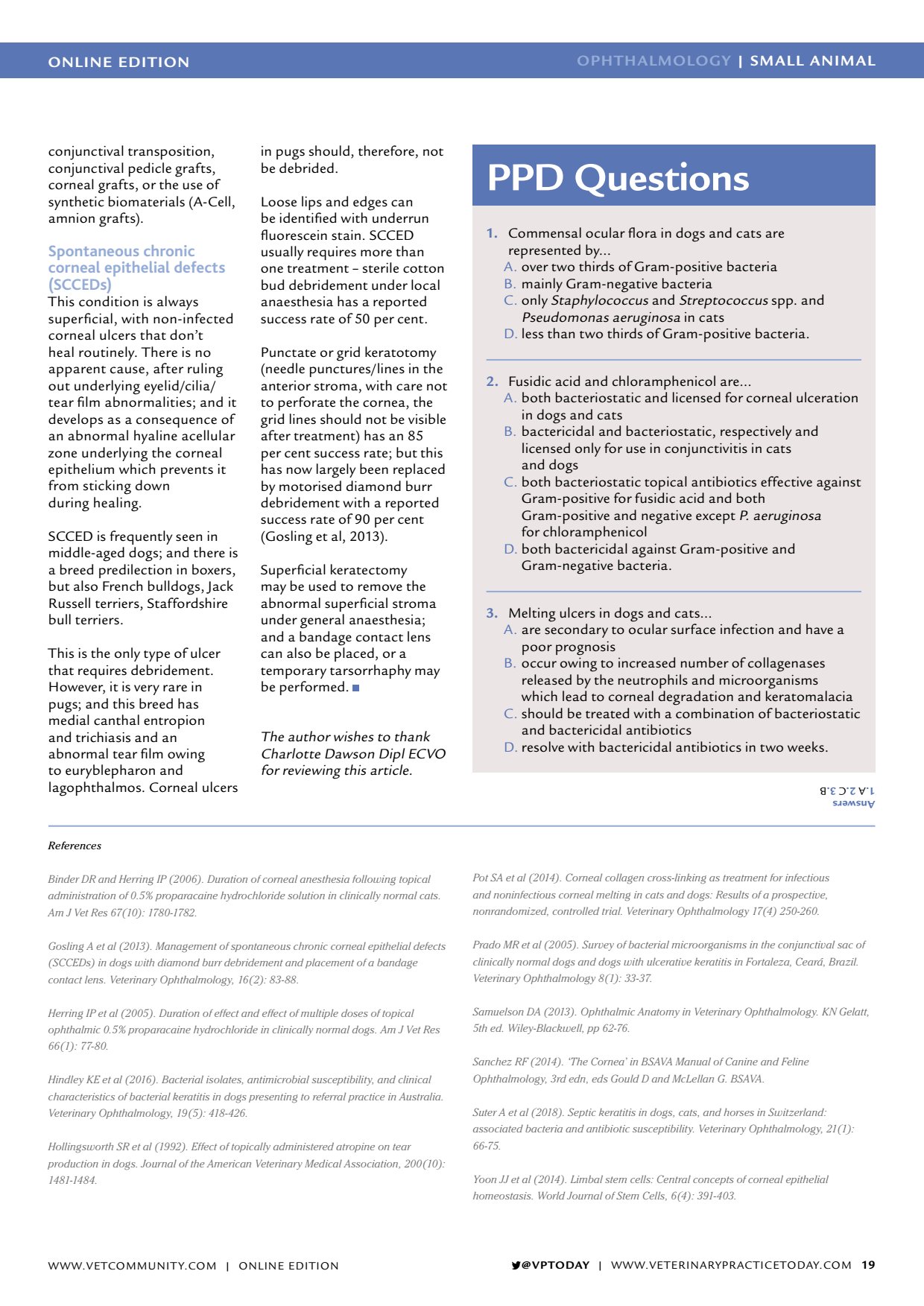Questions Spontaneous chronic
ONLINE EDITION OPHTHALMOLOGY | SMALL ANIMAL VPTODAY | WWW.VETERINARYPRACTICETODAY.COM 19 References Binder DR and Herring IP (2006). Duration of corneal anesthesia following topical administration of 0.5% proparacaine hydrochloride solution in clinically normal cats. Am J Vet Res 67(10): 1780-1782. Gosling A et al (2013). Management of spontaneous chronic corneal epithelial defects (SCCEDs) in dogs with diamond burr debridement and placement of a bandage contact lens. Veterinary Ophthalmology, 16(2): 83-88. Herring IP et al (2005). Duration of effect and effect of multiple doses of topical ophthalmic 0.5% proparacaine hydrochloride in clinically normal dogs. Am J Vet Res 66(1): 77-80. Hindley KE et al (2016). Bacterial isolates, antimicrobial susceptibility, and clinical characteristics of bacterial keratitis in dogs presenting to referral practice in Australia. Veterinary Ophthalmology, 19(5): 418-426. Hollingsworth SR et al (1992). Effect of topically administered atropine on tear production in dogs. Journal of the American Veterinary Medical Association, 200(10): 1481-1484. PPD Questions 1. Commensal ocular flora in dogs and cats are represented by A. over two thirds of Gram-positive bacteria B. mainly Gram-negative bacteria C. only Staphylococcus and Streptococcus spp. and Pseudomonas aeruginosa in cats D. less than two thirds of Gram-positive bacteria. 2. Fusidic acid and chloramphenicol are A. both bacteriostatic and licensed for corneal ulceration in dogs and cats B. bactericidal and bacteriostatic, respectively and licensed only for use in conjunctivitis in cats and dogs C. both bacteriostatic topical antibiotics effective against Gram-positive for fusidic acid and both Gram-positive and negative except P. aeruginosa for chloramphenicol D. both bactericidal against Gram-positive and Gram-negative bacteria. 3. Melting ulcers in dogs and cats A. are secondary to ocular surface infection and have a poor prognosis B. occur owing to increased number of collagenases released by the neutrophils and microorganisms which lead to corneal degradation and keratomalacia C. should be treated with a combination of bacteriostatic and bactericidal antibiotics D. resolve with bactericidal antibiotics in two weeks. Answers 1. A 2. C 3. B conjunctival transposition, conjunctival pedicle grafts, corneal grafts, or the use of synthetic biomaterials (A-Cell, amnion grafts). Spontaneous chronic corneal epithelial defects (SCCEDs) This condition is always superficial, with non-infected corneal ulcers that dont heal routinely. There is no apparent cause, after ruling out underlying eyelid/cilia/ tear film abnormalities; and it develops as a consequence of an abnormal hyaline acellular zone underlying the corneal epithelium which prevents it from sticking down during healing. SCCED is frequently seen in middle-aged dogs; and there is a breed predilection in boxers, but also French bulldogs, Jack Russell terriers, Staffordshire bull terriers. This is the only type of ulcer that requires debridement. However, it is very rare in pugs; and this breed has medial canthal entropion and trichiasis and an abnormal tear film owing to euryblepharon and lagophthalmos. Corneal ulcers in pugs should, therefore, not be debrided. Loose lips and edges can be identified with underrun fluorescein stain. SCCED usually requires more than one treatment sterile cotton bud debridement under local anaesthesia has a reported success rate of 50 per cent. Punctate or grid keratotomy (needle punctures/lines in the anterior stroma, with care not to perforate the cornea, the grid lines should not be visible after treatment) has an 85 per cent success rate; but this has now largely been replaced by motorised diamond burr debridement with a reported success rate of 90 per cent (Gosling et al, 2013). Superficial keratectomy may be used to remove the abnormal superficial stroma under general anaesthesia; and a bandage contact lens can also be placed, or a temporary tarsorrhaphy may be performed. The author wishes to thank Charlotte Dawson Dipl ECVO for reviewing this article. Pot SA et al (2014). Corneal collagen cross-linking as treatment for infectious and noninfectious corneal melting in cats and dogs: Results of a prospective, nonrandomized, controlled trial. Veterinary Ophthalmology 17(4) 250-260. Prado MR et al (2005). Survey of bacterial microorganisms in the conjunctival sac of clinically normal dogs and dogs with ulcerative keratitis in Fortaleza, Ceará, Brazil. Veterinary Ophthalmology 8(1): 33-37. Samuelson DA (2013). Ophthalmic Anatomy in Veterinary Ophthalmology. KN Gelatt, 5th ed. Wiley-Blackwell, pp 62-76. Sanchez RF (2014). The Cornea in BSAVA Manual of Canine and Feline Ophthalmology, 3rd edn, eds Gould D and McLellan G. BSAVA. Suter A et al (2018). Septic keratitis in dogs, cats, and horses in Switzerland: associated bacteria and antibiotic susceptibility. Veterinary Ophthalmology, 21(1): 66-75. Yoon JJ et al (2014). Limbal stem cells: Central concepts of corneal epithelial homeostasis. World Journal of Stem Cells, 6(4): 391-403. WWW.VETCOMMUNIT Y.COM | ONLINE EDITION
